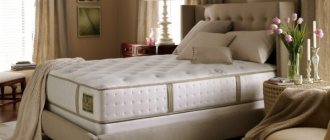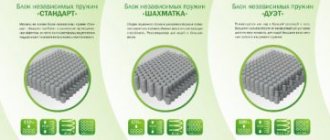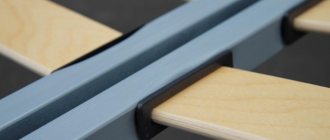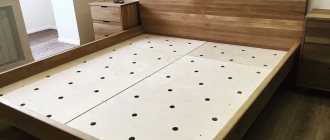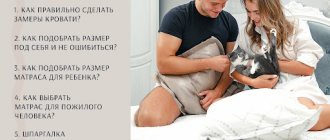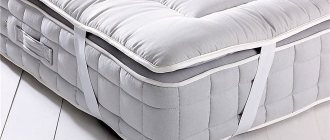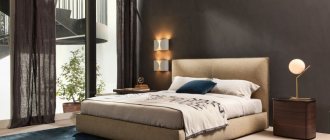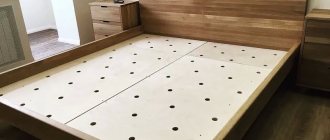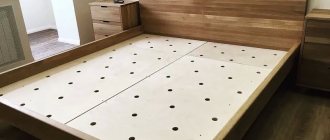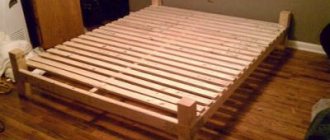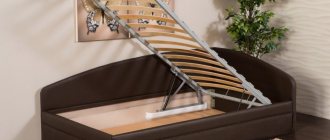Despite their almost completely identical appearance, different mattresses can differ greatly in their properties and content.
There are two main types of mattresses :
- Spring . Classic spring mattresses are almost never found today. They were replaced by models with an independent spring block. Each spring in such mattresses has its own individual soft cover and performs work regardless of other springs. This improves orthopedic properties.
- Springless . They consist of various fillers and have a higher degree of rigidity. This option is recommended for children and people suffering from back and neck pain.
One of the most popular are anatomical mattresses. They most accurately repeat the shape of the human body during sleep and rest. Only springless mattresses or models with independent spring blocks can be anatomical. Conventional springs will not allow the mattress to follow the shape of the human body.
When choosing a model, consider the degree of mattress hardness . Mattresses can be of the following types:
- Soft . They have good orthopedic properties. They provide excellent support and conform to the body's shape. This option is suitable for the elderly and people suffering from joint diseases and spinal pathologies. The softest fillers are artificial and natural latex.
- Medium hardness . The average degree of rigidity is achieved through the simultaneous use of hard (coconut coir) and elastic (latex, polyurethane foam) fillers. They support the body well and are recommended if a person has problems with the thoracic region.
- High rigidity . Contains only hard fillers. Recommended for adults and children, as well as those who suffer from spinal diseases. Coconut coir and struttofiber are most often used as filler.
The differences between mattresses also lie in the type of filler :
- Natural . These include: natural latex, coconut coir, felt, horsehair, wool and cotton.
- Artificial . This category includes: artificial latex, polyurethane foam, memoryform (polyurethane foam with memory effect).
There are double-sided models . This option is convenient because each side can have its own degree of rigidity. For example, you can buy a mattress, one side of which is hard and the other medium, and change them depending on your wishes and health.
Content
- Orthopedic or anatomical
- Which mattress to choose - step-by-step instructions
- What types of mattresses are there?
- Why is mattress firmness important?
- Taking into account the weight of those sleeping
- Choosing a mattress by size and height
- Choosing a mattress based on filling material
- A few words about the orthopedic base
- Cover and mattress cover
- How to care for your mattress
- Mattress manufacturers
- Summarize
A person spends up to a third of his life sleeping, and children sleep almost constantly in the first years. This is exactly the time when the body rests from daily stress and restores strength. While you sleep, not only your muscles relax - your brain also “reboots”, sorting out the information received during the day, because it’s not for nothing that the saying says: “The morning is wiser than the evening.”
Scientists say that sleep is even more important than food, because without food you can live for two weeks, but without sleep a person cannot last even ten days. An uncomfortable sleeping place will not allow you to fully relax; in the morning you will be left with a feeling of fatigue, which will gradually accumulate and will soon manifest itself not only as a depressed mood, decreased performance and inability to concentrate on everyday tasks, but also problems with the musculoskeletal system. That is why it is so important that the sleeping place is comfortable, as comfortable as possible for sleeping, and the main element in this is the right mattress.
conclusions
The right mattress will allow you to forget about insomnia, pain in the muscles and spine, and allergic diseases. Thanks to a comfortable and healthy sleep, the feeling of chronic fatigue will go away, and in return you will feel cheerfulness and good mood in the morning.
SON.ru will help you with your choice
Our specialists are the best experts in matters of comfortable sleep and are always ready to help you. We are in touch and will answer all questions. The consultation is absolutely free.
Orthopedic or anatomical
All types of mattresses can be divided into two categories: orthopedic and anatomical. There is a widespread belief that most good mattresses are orthopedic, which is completely untrue. This category includes products designed to solve problems with the spine or prevent them from arising. An orthopedic mattress can be called a mattress that will allow the spine to be straight during sleep, without curvature and muscle tension. This will help you get rid of unpleasant sensations, protect you from worsening the situation with existing diseases, and serve as additional prevention against the onset of diseases of the musculoskeletal system. It is worth noting that if you have any problems with the spine, you should consult an orthopedic doctor, who will recommend which mattress characteristics are best suited to a specific disease.
Choosing a mattress specifically for yourself is important for several reasons. Eg:
- If a fat person rests on an overly soft mattress, the lumbar region will be lower than the arms and legs, as a result of which the spine will be curved during sleep. In this case, the orthopedic effect can be obtained by using a hard or semi-rigid mattress.
- For a person of average build, the situation is the opposite - a hard mattress will not bend enough and the spine will take an incorrect position during sleep. In this case, a softer mattress will have an orthopedic effect.
To the category of anatomical mattresses
These include models that follow the contours of a person’s figure, providing the necessary support for all areas of the body during sleep. Usually this can be done with a special filler made from high-tech foam with the addition of hydrocarbons. This material bends optimally to the curves of the human body and retains this shape during sleep, creating a feeling of weightlessness and lightness.
To summarize: most anatomical mattresses can be considered orthopedic, but not all orthopedic ones have an anatomical effect, especially when it comes to high-hardness mattresses.
Which mattress to choose - step-by-step instructions
To choose a good orthopedic mattress that is ideal for you, you need to understand what qualities you should pay attention to.
Main characteristics:
- Mattress type. There are only two main types of models for sale - spring and springless. In the first, the basis of the design is spring blocks, dependent or independent. Springless models are made from one or several continuous layers of filler.
- Mattress hardness. Models with spring and springless construction are characterized by a certain degree of rigidity. There are soft, medium-soft, medium, medium-hard and high hardness. This parameter depends on the number of springs, their design and the rigidity of the filler material.
- Sleeping weight. This factor must be taken into account when purchasing a mattress. So, for example, people of average weight (from 60 to 90 kg) can choose the hardness of mattresses at their discretion.
- Dimensions. Selected according to the size of the bed: single, one-and-a-half or double mattress.
- Filling material. Not only the rigidity of the mattress depends on it, but also the cost and durability.
What types of mattresses are there?
Main types of mattresses:
- spring
- springless
- inflatable
- aquatic
Let's take a closer look at each type.
Spring mattresses are divided into two categories: with an independent spring block and dependent springs:
- With a dependent spring block (Bonnel mattresses). Each spiral spring is rigidly connected to the others, so when loaded, they all begin to move. The advantage of such mattresses is mechanical strength and affordable cost. Such models can withstand a lot of weight, but the orthopedic effect is very modest; moreover, over time, dents appear in certain areas, and the springs begin to creak. When buying a mattress with dependent springs for two people, you must take into account the difference in their weight. If one user is significantly heavier than the other, the lighter one will literally roll towards the massive person.
- With independent block. In them, each spring is placed in a separate independent case, so they are considered the best mattresses for sleeping, because only those elements that bear the load sag. This provides the necessary support for the spine and avoids the “hammock effect.” This design allows you to achieve a high orthopedic effect with a targeted effect. The standard number of springs is 250 per square meter, but there are models with 500 and even 900-1000 springs. Such models are recommended for people with heavy weight, as well as those who need maximum orthopedic support. The cost directly depends on the number of spring blocks: the more there are, the more expensive the mattress.
In springless mattresses, the base is made of a continuous layer of one type of filler or several different ones. Most often, polyurethane foam, latex, holofiber or coconut fibers are used as filler. The optimal combination is when the top soft layer provides comfort, taking an anatomical shape, and underneath there is a harder material that gives the mattress the necessary rigidity and does not allow it to “sink” into it. This is a suitable option for children and teenagers, as well as adults with a thin build. This mattress is perfect for a summer house or a rented apartment.
An air mattress is convenient because of its mobility: if necessary, it can be quickly unfolded, and after use, deflated and hidden in a closet. For outdoor recreation or temporary reception of guests for a day or two, this is an excellent choice, but constant rest on such a mattress can negatively affect the health of the back and neck. In addition, the mattress can be easily damaged, and it is not entirely comfortable for two people to sleep on it.
A water mattress is a case filled with water. Budget models are not suitable for two people because they do not have chambers, and the movements of one person will cause the entire mattress to vibrate. Much more convenient are waterbeds divided into two or more independent water chambers. The advantages include the fact that the mattress optimally adapts to the curves of the body, and models equipped with a heating system are very convenient for use in the cold season, especially for people with arthritis, rheumatism or muscle pain. The disadvantages of a water mattress include its fairly large weight - from 100 to 900 kg, and difficulties with installation and connection. In addition, it is necessary to monitor the quality of the liquid, add special reagents that prevent the proliferation of microorganisms, and completely change the water every 2-3 years.
Guarantee
The warranty period for the mattress begins from the moment of payment. Like any other product, you can return it within 14 days if a manufacturing defect is found.
Non-warranty cases
The product will not be exchanged and money will not be returned if:
- mechanical damage to the surface (stains, cuts, holes) was detected;
- the side handles are torn off (they are intended only for turning the mattress over);
- metal frames are bent (during transportation);
- the surface of the cover is lumpy (incorrect base for the mattress);
- the product turned out to be too high or uncomfortable;
- unsuitable appearance due to improper use;
- dents less than 3 cm (maximum load selected incorrectly);
- unpleasant smell (need to ventilate more often).
The examination can accurately determine whether the mattress was deliberately damaged or whether it is the manufacturer’s fault.
Cases of guaranteed return
The following defects are considered to be a factory defect of the mattress:
- spring blocks or individual elements are damaged (creaking, pits, bulges);
- uneven stitching on the cover;
- depressions not related to the shape of the body;
- incorrect geometry.
The buyer needs to remember that the product is submitted for examination in its original form: without blots, snags, with the label intact.
How to issue a return under warranty
If you buy a mattress directly from the manufacturer, he will replace the defective product without any problems. But dealers rarely engage in such activities. Therefore, you need to clarify the time of return in advance before the contract is finalized.
If you find defects on a new item, you must contact the supplier or official representative. Addresses can be found on the Internet or on the warranty card.
Some companies still require you to show a sales or cash receipt as proof of purchase. But modern sellers work without documents - by scanning a barcode.
At the point of sale, the buyer writes a statement with a detailed description of the defect, and the receiving manager writes a complaint. The applicant receives one copy, the second remains with the seller, and the third is transferred to the manufacturer.
By law, the entire return process does not exceed 40 days:
- 10 days to review the complaint;
- 30 days for examination.
But large companies with a good reputation prefer to make up for the incident faster. They either fix the defect or exchange the damaged mattress for a new one. When repairing a product, damaged decorative elements are not restored.
If the seller refuses to issue a return, you can send the application by registered mail with notification to the legal address of the company. In case of other illegal actions, it is better to immediately write a complaint to Rospotrebnadzor. An unscrupulous merchant will be fined and required to exchange the goods.
Why is mattress firmness important?
Mattress hardness
– one of the most important criteria for choosing a suitable model. This indicator determines how correctly the spine will be positioned during sleep, avoiding unnatural bends. The required degree of rigidity is selected depending on the weight and height of the user, as well as age and health.
For example, soft and moderately soft mattresses are chosen for children from 8 to 15 years old and the elderly. Softness is provided by various layers: latex, holofiber, orthopedic foam and other materials. A person weighing less than 80 kg is recommended to use a medium-soft mattress. The required rigidity is achieved by combining fillers of different softness. For example, coconut coir or sisal is used as a rigid base, and a soft layer of polyurethane provides comfort. Healthy people of average build and height weighing from 80 to 110 kilograms need medium-hard models, and those with a body weight of more than 120 kg and problems with the spine need medium-hard or hard ones. In such models, coir, sisal and other dense and rigid materials are used.
The table shows examples of the relationship between height, weight and mattress hardness.
| Height Weight | up to 50 | 50-60 | 60-70 | 70-80 | 80-90 | 90-100 | 100-110 | 110-120 | more than 120kg |
| up to 150 | **** | **** | ***** | ***** | ***** | ***** | ***** | ***** | ***** |
| 150-155 | **** | **** | **** | **** | ***** | ***** | ***** | ***** | ***** |
| 155-160 | *** | **** | **** | **** | **** | ***** | ***** | ***** | ***** |
| 160-165 | *** | *** | *** | **** | **** | **** | ***** | ***** | ***** |
| 165-170 | ** | *** | *** | *** | **** | **** | **** | ***** | ***** |
| 170-175 | ** | ** | *** | *** | *** | **** | **** | **** | ***** |
| 175-180 | * | ** | ** | *** | *** | *** | **** | **** | **** |
| 180-185 | * | * | ** | *** | *** | *** | *** | **** | **** |
| 185-190 | * | * | * | *** | *** | *** | *** | *** | **** |
| 190-195 | * | * | * | ** | *** | *** | *** | *** | *** |
| 195-200 | * | * | * | * | ** | *** | *** | *** | *** |
| ˃ 200 | * | * | * | * | * | ** | *** | *** | *** |
| * – soft, ** – medium-soft, *** – medium, **** – medium-hard, ***** – hard | |||||||||
A special category includes mattresses with zones of different hardness: longitudinal or transverse. They are needed in two cases: firstly, if two people of different builds sleep on the mattress. In this case, a heavier person needs a zone of increased rigidity, and a lighter person needs a soft part of the mattress. The second case is transverse zoning, which allows you to distribute the load differently, for example, a reinforced middle zone and softer areas for the head, shoulders and legs. There can be from 3 transverse zones for inexpensive mattresses, and up to 5-7 or even 9 for more expensive models. The more zones, the more comfortable the rest and the better the orthopedic properties of the mattress.
Useful tips
- From birth, small children are recommended to sleep on a hard surface, ideally on an orthopedic mattress with a high degree of rigidity. And only after two or three years of age use medium hardness.
- Latex filling, whether natural or artificial, is recommended for people of low weight. They are also suitable for the combined filling of latex and coconut coir.
- Now there are so many mattress manufacturers that they can even make them in a neighboring garage. To ensure the quality and environmental friendliness of a product, ask for its certificate.
- To attract buyers, manufacturers can use exotic materials as fillers - horse hair, seaweed, wool. Not every one of them can boast of being hypoallergenic, so be careful when choosing exotic ones.
- For thin people, children over three years of age and the elderly, moderately soft or medium-hard mattresses are recommended. Large and heavy – hard or moderately hard.
- Do not go to extremes and choose a very hard or very soft surface. You are buying a mattress for more than one year, which means you need to take into account possible diseases of the musculoskeletal system, and also that your weight may change.
- If you prefer to sleep on your side, it is better to do this on a soft mattress; if on your stomach, then on a hard one.
Taking into account the weight of those sleeping
Each mattress is designed for a certain person’s weight, and the manufacturer must indicate this parameter. As a rule, the more load a mattress can withstand, the higher the cost.
When choosing a mattress based on load, you need to pay attention to several nuances:
- the characteristics of double mattresses indicate the load on only one sleeping place,
- when choosing a load value, you need to choose a model that corresponds to the weight of a more massive partner,
- if the difference in the weight of sleepers is more than 40 kg, it is better to buy a mattress with different levels of hardness of the sleeping places,
- To ensure a safety margin under increased loads, it is necessary to choose a mattress that is 10-20 kg more than the weight of the sleeper. This is also necessary if the mattress is purchased for a child’s growth.
Choosing a mattress by size and height
Ideally, you should buy both a mattress and a bed of the same size at the same time. The dimensions of the mattress must exactly match the dimensions of the bed niche, and the gap should not be more than 2 cm, otherwise the mattress will move, which is not only uncomfortable during sleep, but will also lead to premature wear.
If you have a double bed, then you can safely buy two single mattresses, this is especially true if the sleepers have different weights or health conditions and need different hardness of the sleeping places. The length of the mattress is selected to be at least 15 cm greater than a person’s height.
As an option, you can purchase the “Tango” model - a double mattress with individual hardness for each bed. These are created specifically for married couples with a large difference in weight.
How to choose a mattress for a double bed, one and a half bed and a single bed:
- single mattress: 80x200 cm or 90x200 cm
- one and a half: 120x200 cm or 140x200 cm
- double: 160x200 cm, 180x200 cm or 200x200.
The height of the mattress is selected depending on the age and weight of the owner. Low models, 10-15 cm, are perfect for children, teenagers and the elderly. For a person of average build, a height of 15-19 cm is recommended, but the most popular mattresses are with a height of 19 to 35 cm.
Choosing a mattress based on filling material
As the basis of mattresses, natural or synthetic fillers are used, the properties of which are as similar as possible to natural ones. Not only comfort during sleep depends on the material, but also cost, rigidity and service life.
Main types of fillers:
- Latex
is an elastic, elastic, hypoallergenic material that can restore its shape and has a long service life. It can be natural (made from processed and foamed rubber tree sap) or synthetic. Artificial latex refers to highly elastic polyurethane foams. Latex board is used as the main filler and in combination with other materials. Latex can be soft and quite hard.
- Coconut coir
is a natural material made from coconut fibers. It is considered one of the best fillers. Coir provides good ventilation, has excellent moisture-proof and antibacterial properties, does not cause allergies, and is not susceptible to rotting.
- Struttofiber and holofiber
are affordable semi-natural or artificial fillers with properties reminiscent of natural wool. They have a wide range of hardness levels, are lightweight, hypoallergenic and durable. In struttofiber, the fibers are arranged vertically; additives from goat wool, horsehair or flax threads can be used in the composition. In holofiber, the fibers are arranged randomly, so it is softer.
- Polyurethane foam (foam rubber)
is an inexpensive synthetic material. Used in mid-price mattresses. Elastic, lightweight, but subject to deformation and has a short service life. Often used in double-sided mattresses with different levels of firmness on the sides, for example, with coconut coir.
- Polyurethane foam
combined with latex. Such combined mattresses are cheaper than those made entirely from natural latex, have a long service life, and have orthopedic properties. - Viscoelastic foam
is a synthetic material that has a dense and elastic structure that completely follows the shape of the body, and without load it restores its original state within a few minutes. Thanks to these properties, models with this filler are characterized by an excellent orthopedic effect.
- Sisal
is a tough, environmentally friendly material made from the leaves of some types of agave. It has high rigidity and strength, does not lose its shape for a long time, and has bactericidal and hypoallergenic properties. Most often used as a layer between a low-stiffness filler and a spring block for proper load distribution.
- Felt
- natural or artificial, soft or hard, is made by pressing cotton, wool, linen or synthetic fibers under high temperature. Just like sisal, it is usually placed between a spring block and a softer filler.
- Batting
is a non-woven or knitted, inexpensive material consisting of synthetic, natural or regenerated fibers. It can be needle-punched, in which case the fibers are fastened with vertical stitches, or knitted-stitched - more durable, in which the fibers are stitched with parallel stitches resembling a herringbone. - Sintepon
is a synthetic material consisting of a loosened mass of polyester fibers that has good heat-saving properties. Light, soft, voluminous filler that quickly absorbs and evaporates moisture. - Spunbond
is a non-woven material made from thin polypropylene threads connected using needle-punched or thermospun technology. Environmentally friendly, non-toxic filler, with good breathability. Lightweight, not affected by moisture, does not rot or mold. - Buckwheat husk
is a natural, hypoallergenic material. Excellent air permeability and removes excess moisture. Due to its structure, it has a massage effect and helps with osteochondrosis and scoliosis in children. Often used in double-sided mattresses in combination with coconut coir. - Hollcon
is a material made from polyester fiber. The main advantages are a long service life, does not burn, is not afraid of moisture, is resistant to high temperatures (up to +95°C) and has good heat-saving properties. - Lyocell
is a natural material obtained from cellulose. It is characterized by hygroscopicity, allows air to pass through well, has high strength and wear resistance, and does not lose its shape after washing. - Highly elastic foam
is a material obtained through the use of cold foam technology and a unique molding method. Mattresses made from this material are able to adapt to the curves of the body, distribute pressure evenly and are used for the manufacture of orthopedic structures.
Options for children
Children's bedrooms should be equipped with everything necessary for healthy sleep for the baby. A thin mattress will not be able to maintain the correct position of the spine and may negatively affect the formation of the skeleton. It is better to opt for a rigid model that has all the necessary orthopedic properties.
Bedrooms for children today are equipped with bunk or loft beds, which must contain a properly selected mattress. To do this, it must have the following properties:
- For children, you need to choose the right rigid models. A thin and soft mattress can only be used for children under three years of age;
- The size must completely match the shape of the crib. This takes into account the length and width.
Among the filling materials, it is best to opt for coconut fiber, latex, and polyurethane foam. A combination of these fabrics is also allowed.
For a child's bedroom, you can opt for the attic option. The additional presence of an orthopedic effect is important. A thin mattress does not follow the curves of the body well and can disrupt the formation of the skeleton. This situation can be avoided by using an elastic sleeping surface.
The Milan company produces products whose quality is confirmed by certificates. They fully comply with existing GOST standards. Saving on your baby's health is unacceptable. Therefore, the height and dimensions of the mattress should be selected based on health criteria.
A few words about the orthopedic base
In order for the mattress to have the maximum preventive or therapeutic effect, it is necessary to use it with a special orthopedic base. The best option is a frame with elastic slats made of beech or birch. This design provides not only good shock absorption, reducing the load on the musculoskeletal system, but also proper air and moisture exchange. A single base must have at least 15 slats, a double – 30. The frame itself can be with or without legs, made in the form of a metal base or a wooden box. An orthopedic base is used with both types of mattresses - springless and spring.
Types of orthopedic bases:
- Collapsible design
. Convenient model for transportation, for example, to the country. The slats, frame and lath holders are easily assembled into a single structure in accordance with the instructions. - Solid base
. It is purchased assembled and cannot be disassembled. This is the best option for constant use at home. - Frameless base
. A mobile design in which the slats are not attached to the frame, but are connected with tape and placed in the bed niche. - Transformers
. Due to the special design of the base, it can be adjusted to the shape of the body; for example, when watching TV, part of the frame at the head can be raised. - Lifting frames
. Equipped with a mechanism that lifts the entire orthopedic base and gives access to the niches under the berth.
Cover and mattress cover
High-quality outer upholstery of a mattress must meet several requirements:
- Have good breathability. Air circulation will allow moisture to quickly evaporate, thereby maintaining the elasticity of the mattress and the quality of the filler for a long time.
- Elasticity. It is necessary to prevent the fabric from tearing under increased load.
- The upholstery fabric must be durable and wear-resistant.
- Hydrophobicity of the cover. This quality will not allow moisture to accumulate, unpleasant odors to appear and dangerous bacteria to develop.
Usually the cover is made of cotton or linen, some models are sewn from artificial fabrics, but the best option is mixed fiber, when fibers from other fabrics are added to the main material. In addition to cotton and linen, bamboo, lye, and viscose are used. For example, a popular material for covers, jacquard, consists of polyester and cotton threads, making the fabric very durable, but “breathable” and hydrophobic.
The cover can be permanent or removable, which allows you to periodically remove it for washing. In the first case, in order to extend the life of the cover and the mattress itself and keep it clean, it is recommended to use a mattress cover.
What are they:
- The simplest models look like a sheet and are made of thin natural, synthetic or combined fabric. They are fixed on the mattress with corner straps, a bumper or an elastic band around the entire perimeter.
- Waterproof. More expensive models made from a combination of natural and artificial fabrics with a waterproof membrane or special impregnation.
- Some models are made double-sided - the so-called “winter-summer” option, from two different types of fabrics: the summer side, made of silk or cotton, wicks away moisture well and cools, and the winter side, made of warm synthetic fabrics or wool, warms. In this case, each side is marked with a special symbol, most often a snowflake and a sun.
- Covers. Place it on the mattress, covering it completely, and fasten it with a zipper.
- Topper. A dense cover, reminiscent of a thin mattress, is used to adjust the orthopedic properties of the main mattress and can either reduce or increase its hardness.
How to care for your mattress
In order for the mattress to serve as long as possible and not lose its quality after a year or two, you need to follow simple operating rules:
- protect from moisture,
- do not use in rooms with high humidity, at low temperatures (below 15 degrees) and high temperatures (above 30 degrees),
- periodically ventilate the mattress,
- change its position in the horizontal plane once every three months, and in the vertical plane once every six months,
- Do not load the mattress with large point loads.
Precautionary measures
What not to do:
- jumping or walking on a surface;
- store in an upright position;
- fold in half (unless otherwise marked);
- bend the edges or leave them hanging to adjust to the size of the bed;
- exceed the maximum permissible load;
- operate on a bare floor for more than a month;
- pour water over;
- expose to sunlight and high temperatures;
- place next to heating radiators;
- use aggressive cleaning agents.
Any model, with or without springs, is not designed for vertical loads. Therefore, jumping and improper transportation quickly deform the structure. There are models that are not afraid of folding several times. The information is indicated on the label with a special icon. They are suitable for sofas.
Drying in the sun or using a heat gun will cause the inner layers of the mattress to warp. Heating radiators work the same way. To avoid starting a fire, you should not go to bed with an electric heating pad. In the event of a short circuit, even fireproof impregnation will not prevent damage to property.
Stubborn stains will have to be entrusted to professionals; aggressive friction or a chemical substance will hopelessly damage the cover and filling.
Mattress manufacturers
The guarantee of product quality is the name of the manufacturer. In the age of open access to any information from the Internet, it is very easy to ruin your reputation, so each brand cares about the quality of its products and offers only proven products. It’s not easy to say which mattresses are better, but there are a number of manufacturers that have proven themselves well.
The most famous brands:
- Vegas
is a domestic manufacturer that uses imported components and raw materials (Germany, Belgium, the Netherlands), and modern equipment. The quality of goods is checked at the production stage and confirmed by certificates from Belarusian, Russian and European laboratories. - Ascona
is a Russian manufacturer offering a wide range of mattresses with and without springs, in different price categories - both in the middle price segment and premium models. - Dormeo
is an Italian manufacturer of mattresses known in Europe and beyond. Orthopedic and anatomical mattresses are made from ultra-modern high quality materials. - Ormatek
is a Russian manufacturer, one of the market leaders, specializing in the production of single and double mattresses, both spring and springless. - Consul
is the largest holding company that has existed for more than 80 years. Product quality is confirmed by international certificates and meets environmental safety and health standards (Ocko-Tex Standart 100). - Lonax
is a dynamically developing company that provides a full cycle of creating mattresses - from developing new models to sending them to the consumer. The products are certified by Russian and European control authorities. - Barro
is a Belarusian manufacturer with 20 years of experience. The company provides a full production cycle - from the manufacture of springs to complete assembly. Quality is certified according to the international ISO standard. - Toris
, the manufacturer, has reached a level that meets international quality standards during its activity. - Ikea
is a leading Italian manufacturer using the best materials in high-tech production. All products are certified and comply with strict EU standards.
Upholstery
Today, to create comfortable conditions at night, manufacturers offer a wide range of mattresses. The world-famous manufacturer Milan always studies customer demand. Various materials can be used for upholstery and filling of structures.
The first layer is a layer filter. Modern hard materials are used for its production. It all depends on the individual preferences of the client. The best options are those made from heat-pressed felt and spunbond. These types of matter fully meet all requirements.
Often, jacquard fabric is used for upholstery, which is characterized by high strength and durability. But it’s best to avoid synthetic upholstery. This is especially true for flock, which is not ventilated and cannot allow water and moisture to pass through. If you choose between quilted and button models, then it is better to give preference to the first option, in which the upholstery is quilted together with the filling.
Recently, some manufacturers have been producing mattresses with anti-stress upholstery, into which copper or silver threads are woven. This fabric can remove static electricity from a person and has a calming effect on the nervous system.
Jacquard
Spunbond
Flock
Three-zone knitwear
